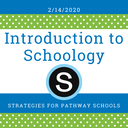|
As the world of education has turned more digital than ever, I continue to find myself using the lens of User Experience when advising schools on how to best use technology to meet the needs of students. I highly doubt this will be the last time I blog about this connection, as I've been fascinated by this intersection for many years now. I am convinced that by embracing this perspective, we can truly revolutionize the way both education and work are done. In my current role, I think of teachers and students as the users of our Learning Management Systems and recommend strategies schools can use to provide the best user experience possible. Below are a couple of ways this has showed up, as well as the resources I've recently used to gain additional insight and perspective for all things UX and design. I hope you enjoy my thoughts and find them helpful for rethinking ways to solve some of education's toughest challenges. Course Design - Visuals and Course Organization With instruction and professional development needing at least some asynchronous component, creating courses that are easy to navigate and visually appealing is essential to ensure strong engagement. I encourage folks to consider the basic question, "If I entered this course with no context or support, would it be clear what I need to do to be successful?" This includes clearly communicating how to best get support for the course and ways to build relationships between participants and the facilitator in a variety of formats - text, image, audio, video, etc.
Communication I like to think of the platforms I support as the learning ecosystems for users. While they may be taking their courses on the platform, I also like to consider how the platform can be used to provide other educational wraparound supports like communication, resource distribution, and potentially solve other problems facing their school. My favorite conversations with schools are those that lead to 'off-label' uses of tools within the platform to solve unique problems. For example, one school wanted to create a space for students to engage in fun online activities and social opportunities during remote learning. Knowing that Schoology is the digital 'place' where students are visiting, I know it is helpful to contain as much school business within the platform as possible. We ultimately decided to create a school-wide Schoology course to post these opportunities and bulk-enrolled every single student in the school so they would automatically have access without any action on their part. In general, I like to think of how to make it easy to do the right thing and harder to do anything else. To support schools with utilizing the platform as a one-stop-shop to it's fullest potential, I rolled out this Implementation Guide for schools. While it is by no means an exhaustive list, I think it provides some high-leverage strategies for schools utilizing Schoology in a way that stays true to UX concepts of creating the best possible user experience. Inspiration and Resources If you've read any of my previous blog posts, you may already know I'm a bit of a podcast junkie. Of course, there is a podcast where I get some of my main UX inspiration.
For all things design, I often turn back to this classic text from my days in graduate school.
And last, but certainly not least, here are some newer reads that have helped me understand more specifics about the field of UX. For those looking to browse the topic without buying anything, I encourage you to look for these books at your local library.
As I continue to continue examining how UX and education intersect, I'm sure I will create more posts to process my learning on the topic. If you have any suggestions or just want to chat about this concept, feel free to type in the comments below or send me an email at [email protected]. I hope everyone is doing well during this challenging time and is able to find the resource they need to make it through.
0 Comments
Leave a Reply. |
AuthorMattea Garcia is a human-centered problem-solver dedicated to improving learning and technology experiences. This blog is dedicated to reflections on leadership, educational technology, instructional coaching, educational equity, and more. Archives
June 2022
Categories |

 RSS Feed
RSS Feed
